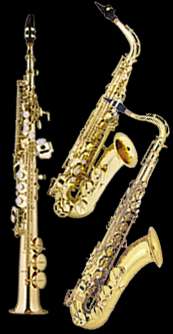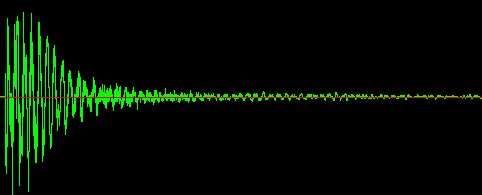







The Expressive Elements of Music - Add variety and contrast to music
Understanding timbre involves the study of physics and the examination of sound waves and frequencies of sound. Below is a segment from the "Physics Classroom."
| Pitch and
Frequency
A sound wave, like any other wave, is introduced into a medium by a vibrating object. The vibrating object is the source of the disturbance which moves through the medium. The vibrating object which creates the disturbance could be the vocal chords of a person, the vibrating string and sound board of a guitar or violin, the vibrating tines of a tuning fork, or the vibrating diaphragm of a radio speaker. Regardless of what vibrating object is creating the sound wave, the particles of the medium through which the sound moves is vibrating in a back and forth motion at a given frequency. The frequency of a wave refers to how often the particles of the medium vibrate when a wave passes through the medium.
A commonly used unit for frequency is the Hertz (abbreviated Hz), where 1 Hertz = 1 vibration/second. As a sound wave moves through a medium, each particle of the medium vibrates at the same frequency. Certain sound waves when played (and heard) simultaneously will produce a particularly pleasant sensation when heard, are are said to be consonant. Such sound waves form the basis of intervals in music. For example, any two sounds whose frequencies make a 2:1 ratio are said to be separated by an octave and result in a particularly pleasing sensation when heard; that is, two sound waves sound good when played together if one sound has twice the frequency of the other. Similarly two sounds with a frequency ratio of 5:4 are said to be separated by an interval of a third; such sound waves also sound good when played together. Examples of other sound wave intervals and their respective frequency ratios are listed in the table below.
The ability of humans to perceive pitch is associated with the frequency of the sound wave which impinges upon the ear. Because sound waves are longitudinal waves which produce high- and low-pressure disturbances of the particles of a medium at a given frequency, the ear has an ability to detect such frequencies and associate them with the pitch of the sound. But pitch is not the only property of a sound wave detectable by the human ear." The Physics Classroom on Musical Instruments - http://www.glenbrook.k12.il.us/gbssci/phys/Class/sound/u11l5a.html "Nearly all objects, when hit or struck or plucked or strummed or somehow disturbed, will vibrate. If you drop a meter stick or pencil on the floor, it will begin to vibrate. If you pluck a guitar string, it will begin to vibrate. If you blow over the top of a pop bottle, the air inside will vibrate. When each of these objects vibrate, they tend to vibrate at a particular frequency or a set of frequencies. The frequency or frequencies at which an object tends to vibrate with when hit, struck, plucked, strummed or somehow disturbed is known as the natural frequency of the object. If the amplitude of the vibrations are large enough and if natural frequency is within the human frequency range, then the object will produce sound waves which are audible.
Timbre All objects have a natural frequency or set of frequencies at which they vibrate. The quality or timbre of the sound produced by a vibrating object is dependent upon the natural frequencies of the sound waves produced by the objects. Some objects tend to vibrate at a single frequency and they are often said to produce a pure tone. A flute tends to vibrate at a single frequency, producing a very pure tone. Other objects vibrate and produce more complex waves with a set of frequencies which have a whole number mathematical relationship between them; these are said to produce a rich sound. A tuba tends to vibrate at a set of frequencies which are mathematically related by whole number ratios; it produces a rich tone. Still other objects will vibrate at a set of multiple frequencies which have no simple mathematical relationship between them. These objects are not musical at all and the sounds which they create are best described as noise. When a meter stick or pencil is dropped on the floor, a vibrates with a number of frequencies, producing a complex sound wave which is clanky and noisy. The actual frequency at which an object will vibrate at is determined by a variety of factors. Each of these factors will either effect the wavelength or the speed of the object. Frequency = speed/wavelength.
|
The Harmonic Series from the Dolmetsch Theory Site - http://www.dolmetsch.com/musictheory27.htm#harmonic
|
Harmonic |
Frequency |
Normalized |
Note name |
Closeness in % |
|
1 |
440Hz. |
440Hz |
A |
100% |
|
2 |
880Hz. |
440Hz |
A |
100% |
|
3 |
1320Hz. |
660Hz |
E |
100% |
|
4 |
1760Hz. |
440Hz |
A |
100% |
|
5 |
2200Hz. |
550Hz |
C# |
99% |
|
6 |
2640Hz. |
660Hz |
E |
100% |
|
7 |
3080Hz. |
770Hz |
G |
98% |
|
8 |
3520Hz. |
440Hz |
A |
100% |
|
9 |
3960Hz. |
495Hz |
B |
100% |
|
10 |
4400Hz. |
550Hz |
C# |
99% |
|
11 |
4840Hz. |
605Hz |
D |
103% |
|
12 |
5280Hz. |
660Hz |
E |
100% |
|
13 |
5720Hz. |
715Hz |
F# |
97% |
|
14 |
6160Hz. |
770Hz |
G |
98% |
|
15 |
6600Hz. |
825Hz |
G# |
99% |

Soundwaves
More on Harmonics from the Soundry - http://library.thinkquest.org/19537/Apps5.html

Soundwaves of Common Objects and Percussion - See Powerpoint with Sounds and Waves
Computer programs are available that allow you to view sound waves recorded with a microphone. Most computers have built-in sound cards (like Soundblaster) that include programs for wave recording and editing. These waves below were recorded with a free downloaded wave editing program. Students enjoy watching the sound waves and learning to manipulate the waves with effects (echo, volume, reversal, cut/paste segments, etc.). You may have to install the wave studio portion of your soundcard program application since some of the options are frequently not automatically included in the original installation.
Screenshot of the Soundblaster Wave Studio
| Airplane |  |
| Telephone Ring |  |
| Clock Ticking |  |
| Bell |  |
| Cymbal Crash |  |
| Snare Drum |  |
| Bass or Kick Drum |  |
Websites of Interest - Science, Math, and Sound
Musical Instruments of the Orchestra
Visit the San Francisco Symphony Kids Site - http://www.sfskids.org/templates/splash.asp to hear and view all the instruments of the orchestra!
Energy in the Air Thinkquest Site - http://tqjunior.thinkquest.org/5116/
Musical Instruments - U of Michigan - http://www.si.umich.edu/chico/instrument/
The Virtual Museum
Musical Instrument Websites
Musical Instrument Website Resources (University of Indiana) - http://www.music.indiana.edu/music_resources/instr.html
Chicago Symphony Orchestra Tour - http://www.cso.org/intro_tour.taf
Conn Instruments Website - http://www.unitedmusical.com/
Learn About Instruments - http://datadragon.com/education/instruments/
Instrument Encyclopedia - http://www.si.umich.edu/chico/instrument/
The Metropolitan Museum - http://www.metmuseum.org/collections/department.asp?dep=18
The San Francisco Kids Fun with Music Website - http://www.sfskids.org/
The Music Lab - http://www.sfskids.org/templates/musiclab.asp?pageid=4
This site is a great way to learn about the basics of music - and in particular dynamics and tempo. Click on the pictures to go directly to the pages. You may want to use one of these activities (or the instrument activities) to engage your students in the study of timbre, dynamics, or tempo. The students can hear the difference in speed (tempo) and loudness (dynamics).
Dynamics
| Abbreviation | Term | Meaning |
|
DYNAMICS |
||
|
|
Crescendo | get louder |
|
|
Diminuendo | get quieter |
| p | Piano | quiet |
|
pp |
Pianissimo | very quiet |
|
ppp |
Pianississimo | very, very quiet |
| mp | mezzo piano | quite quiet |
| mf | mezzo forte | quite loud |
| f | forte | loud |
| ff | fortissimo | very loud |
| fff | fortississimo | very, very loud |
| sf | sforzando | suddenly very loud |
|
The
general rule is to add an "iss" for every added f or p. |
||
| TEMPO INDICATORS | ||
| Adagio | slow | |
| largo | slow and dignified | |
| andante | flowing, at walking pace | |
| allegro | quick and bright | |
| allegretto | a little slower than allegro | |
| vivace | fast and lively | |
| presto | very quick | |
| accelerando | getting faster | |
| ritenuto (rit.) | holding back | |
| rallentando (rall.) | slowing
tempo
flexible tempo |
|
| rubato | flexible tempo | |
More Music on the Web

Copyright 2003 by Carla Piper, Ed. D.